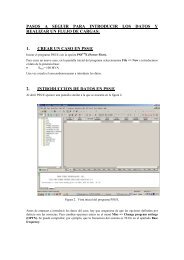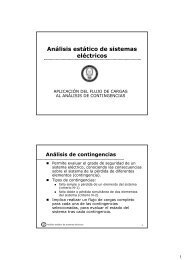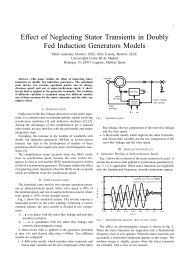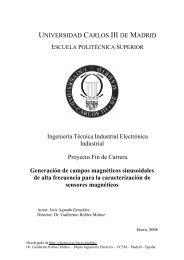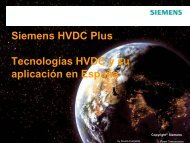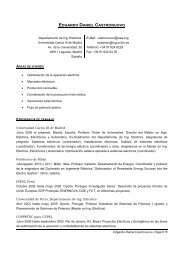Options for th The Energy MIXGENERA 2011 Options for the future ...
Options for th The Energy MIXGENERA 2011 Options for the future ...
Options for th The Energy MIXGENERA 2011 Options for the future ...
Create successful ePaper yourself
Turn your PDF publications into a flip-book with our unique Google optimized e-Paper software.
M<strong>MIXGENERA</strong><br />
<strong>2011</strong><br />
<strong>Options</strong> <strong>for</strong> <strong>th</strong>e <strong>future</strong><br />
November 17, <strong>2011</strong>.<br />
Auditorium of <strong>th</strong>e University Carlos III de Madrid<br />
Leganés, Madrid, Spain.<br />
http://electrica.uc3m.es/mixgenera/<br />
<strong>The</strong> <strong>Energy</strong> Mix at <strong>th</strong>e years 2020 y 2030<br />
ISBN: 978 978-84-614-9978-6<br />
Chairs: Edgardo D. Castronuovo<br />
Víctor Hernández Jiménez<br />
Fernando Soto Martos<br />
Julio Usaola García<br />
Secretary: Ignacio A. Calle<br />
More in<strong>for</strong>mation: ecastron@ing.uc3m.es<br />
Support:
<strong>MIXGENERA</strong> <strong>2011</strong> – November 17, <strong>2011</strong> – Leganés, Madrid, Spain - http://electrica.uc3m.es/mixgenera/ 1<br />
Capture of CO2 during low temperature biomass<br />
combustion in a fluidized bed using CaO.<br />
Construction of a new larger scale experimental<br />
facility<br />
John R. Chamberlain, Francisco J. Alonso Martinez, and Carlos Perez Ros, Gas Natural Fenosa<br />
Abstract—This paper outlines a new experimental test facility<br />
of 300kWt being commissioned in <strong>th</strong>e grounds of Gas Natural<br />
Fenosa’s La Robla coal-fired power plant in <strong>th</strong>e Leon region,<br />
Nor<strong>th</strong>west of Spain, wi<strong>th</strong> <strong>th</strong>e goal to advance <strong>th</strong>e demonstration<br />
of <strong>th</strong>e capture of CO 2 wi<strong>th</strong> CaO in a circulating fluidized bed<br />
(CFB) combustor-carbonator reactor, where <strong>th</strong>e combustion of<br />
biomass wi<strong>th</strong> air occurs simultaneously wi<strong>th</strong> <strong>th</strong>e carbonation of<br />
CaO, <strong>th</strong>ereby capturing <strong>th</strong>e CO 2 released from <strong>th</strong>e combustion<br />
process.<br />
I<br />
Index Terms— Biomass, Carbonate Looping, CO 2 Capture,<br />
I. INTRODUCTION<br />
n order to maintain global warming below 2ºC, <strong>th</strong>e<br />
International <strong>Energy</strong> Agency (IEA) states <strong>th</strong>at Carbon<br />
Capture and Storage (CCS) must provide 20% of <strong>th</strong>e global<br />
CO2 required cuts by 2050; <strong>th</strong>e costs of doing so wi<strong>th</strong>out CCS<br />
will be over 70% higher [1]. <strong>The</strong> integration of CCS wi<strong>th</strong><br />
biomass should result in CO2 “negative emissions” in <strong>th</strong>e<br />
generation of electricity or in o<strong>th</strong>er energy products, which is a<br />
very attractive concept initially recognized by Ishitani and<br />
Johansson [2] and <strong>th</strong>ese positive implications have been<br />
highlighted in many recent studies [3, 4].<br />
This abstract outlines a new experimental test facility of<br />
300kWt currently being commissioned in <strong>th</strong>e grounds of Gas<br />
Natural Fenosa’s La Robla coal-fired power plant in <strong>th</strong>e Leon<br />
region, Nor<strong>th</strong>west of Spain, wi<strong>th</strong> <strong>th</strong>e goal to advance <strong>th</strong>e<br />
demonstration of <strong>th</strong>e capture of CO2 wi<strong>th</strong> CaO in a circulating<br />
fluidized bed (CFB) combustor-carbonator reactor, where <strong>th</strong>e<br />
combustion of biomass wi<strong>th</strong> air occurs simultaneously wi<strong>th</strong> <strong>th</strong>e<br />
This work has been carried out <strong>th</strong>anks to <strong>th</strong>e financial support from<br />
Spanish Centre <strong>for</strong> <strong>th</strong>e Development of Industrial Technology (CDTI) under<br />
<strong>th</strong>e auspices of <strong>th</strong>e projects CENITCO2 and MENOSCO2.<br />
J.R. Chamberlain is wi<strong>th</strong> Gas Natural Fenosa, Madrid, Aveinda San Luis<br />
77, 28033 Spain: (phone +34 01-567-6000; 555; e-mail:<br />
jchamber@gasnatural.com).<br />
F.J. Alonso Martinez is wi<strong>th</strong> Gas Natural Fenosa, Madrid, Aveinda San<br />
Luis 77, 28033 Spain: (e-mail: fjalonso@gasnatural.com).<br />
C. Perez Ros is wi<strong>th</strong> SOCOIN, Pozuelo de Alarcón (Madrid), Parque<br />
Empresarial La Finca, 28233 Spain: (e-mail: cpros@socoin.es).<br />
carbonation of CaO, <strong>th</strong>ereby capturing <strong>th</strong>e CO2 released from<br />
<strong>th</strong>e combustion process. This process intends to exploit <strong>th</strong>e<br />
high reactivity of most natural biomasses permitting <strong>th</strong>e<br />
possibility of combustion at low temperatures (around 700ºC)<br />
and <strong>th</strong>e capability of CaO to absorb CO2 at <strong>th</strong>ese temperatures.<br />
This is a niche application <strong>for</strong> <strong>th</strong>e carbonate looping cycles<br />
<strong>th</strong>at can be applied as a standalone process or in a possible cocombustion<br />
concept when integrated wi<strong>th</strong> an existing <strong>th</strong>ermal<br />
power plant.<br />
Previous results obtained in a 30kWt test facility made up of<br />
two interconnected CFB reactors (combustor-carbonator and<br />
combustor-calciner) located at <strong>th</strong>e facilities of <strong>th</strong>e Spanish<br />
Institute of Coal (INCAR-CSIC) in Oviedo, Spain, have been<br />
presented be<strong>for</strong>e [5, 6] and demonstrate <strong>th</strong>e experimental<br />
feasibility of <strong>th</strong>is concept achieving CO2 capture efficiencies<br />
of over 80% <strong>th</strong>at are remarkably close to <strong>th</strong>ose allowed by <strong>th</strong>e<br />
equilibrium and <strong>th</strong>e combustion mass balances.<br />
(a)<br />
Concentration (% vol.)<br />
25<br />
20<br />
15<br />
10<br />
5<br />
0<br />
19:10 19:20 19:30 19:40 19:50 20:00 20:10<br />
time (h:min)<br />
CO 2<br />
O O 2 analyzer<br />
O 2 probe<br />
0<br />
19:10 19:20 19:30 19:40 19:50 20:00 20:10<br />
time (h:min)<br />
Fig. 1. Example of experimental results in <strong>th</strong>e combustor-carbonator reactor<br />
in a typical experiment. (a) Combustor-carbonator exit gas concentrations of<br />
CO2 and O2 measured by <strong>th</strong>e on-line gas analyzer and O2 zirconia probe (b)<br />
Experimental capture efficiency and maximum capture efficiency allowed by<br />
equilibrium.<br />
In <strong>th</strong>is example, <strong>th</strong>e average CO2 concentration at <strong>th</strong>e exit of<br />
<strong>th</strong>e combustor-carbonator reactor was 3.1 vol%. <strong>The</strong> average<br />
oxygen concentration at <strong>th</strong>e exit of <strong>th</strong>e combustor-carbonator<br />
was 7.6 vol.%. From a combustion mass balance, <strong>th</strong>e CO2<br />
produced by biomass combustion was estimated to be around<br />
Capture Efficiency (%)<br />
100<br />
80<br />
60<br />
40<br />
20<br />
Experimental<br />
Experimental<br />
Equilibrium<br />
(b)
<strong>MIXGENERA</strong> <strong>2011</strong> – November 17, <strong>2011</strong> – Leganés, Madrid, Spain - http://electrica.uc3m.es/mixgenera/ 2<br />
13.6 vol.% , <strong>th</strong>ere<strong>for</strong>e, <strong>th</strong>e average CO2 capture efficiency was<br />
77%. <strong>The</strong> average temperature in <strong>th</strong>e combustor-carbonator<br />
was 690ºC during <strong>th</strong>e period, which according to <strong>th</strong>e<br />
equilibrium of CO2 on CaO allows <strong>for</strong> a 2.4 vol% of CO2<br />
(maximum efficiency allowed by <strong>th</strong>e equilibrium of 81%,<br />
remarkably close to <strong>th</strong>e experimental value).<br />
<strong>The</strong>se positive results justified <strong>th</strong>e construction of <strong>th</strong>e new<br />
larger scale test facility in <strong>th</strong>e grounds of <strong>th</strong>e Gas Natural<br />
Fenosa’s La Robla coal fired power plant <strong>th</strong>at is some 10 times<br />
larger <strong>th</strong>an <strong>th</strong>e 30kW test facility in Oviedo.<br />
II. SCALE OF UP TEST FACILITY<br />
This new facility consists of two interconnected CFB<br />
reactors, <strong>th</strong>e carbonator and calciner bo<strong>th</strong> being 12m high<br />
cylindrical reactors wi<strong>th</strong> a diameter of 600mm. In order to<br />
control <strong>th</strong>e temperature of <strong>th</strong>e biomass combustion wi<strong>th</strong>in <strong>th</strong>e<br />
range of 650-700ºC in <strong>th</strong>e carbonator, a heat exchanger is<br />
installed <strong>th</strong>at employs <strong>th</strong>ermal oil as <strong>th</strong>e cooling medium. <strong>The</strong><br />
calciner is ceramic lined as it operates in <strong>th</strong>e temperature range<br />
of 850-900ºC.<br />
Fig. 2. Images of <strong>th</strong>e 300kWt experimental plant in La Robla Power Plant<br />
actually in <strong>th</strong>e stages of commissioning.<br />
As one of <strong>th</strong>e objectives of <strong>th</strong>is larger test facility is to carry<br />
out longer duration experiments, biomass storage <strong>for</strong> one week<br />
experimentation is contemplated, along wi<strong>th</strong> <strong>th</strong>e capability to<br />
receive fresh supplies during operation, <strong>th</strong>at is sufficient to<br />
provide bo<strong>th</strong> <strong>th</strong>e nominal 1.7T/day of biomass to <strong>th</strong>e<br />
carbonator and 2,5T/day of biomass to <strong>th</strong>e calciner <strong>th</strong>rough<br />
fully automated biomass handling and injection systems.<br />
Limestone storage and injection is also contemplated, capable<br />
of injecting over 0,5T/day <strong>for</strong> make-up if required, which will<br />
be dependent on sorbent deactivation and breakdown. Air is<br />
preheated and supplied to independently to bo<strong>th</strong> <strong>th</strong>e carbonator<br />
and calciner reactors in a controlled manner <strong>th</strong>rough variable<br />
speed <strong>for</strong>ced draft fans. Biomass and air are injected at <strong>th</strong>e<br />
bottom carbonator <strong>th</strong>at will be filled wi<strong>th</strong> a bed of<br />
predominantly CaO and if <strong>th</strong>e temperature of combustion can<br />
be controlled to just below 700ºC, combustion of <strong>th</strong>e biomass<br />
and capture of CO2 <strong>th</strong>rough <strong>th</strong>e reaction wi<strong>th</strong> <strong>th</strong>e CaO to<br />
produce CaCO3 should occur simultaneously. <strong>The</strong> mixture of<br />
gases and solids <strong>th</strong>at leave <strong>th</strong>e top of <strong>th</strong>e carbonator <strong>th</strong>en<br />
passes <strong>th</strong>rough two cyclones situated in series in order to<br />
separate <strong>th</strong>e solids from <strong>th</strong>e combustion gas wi<strong>th</strong>out CO2. <strong>The</strong><br />
solids separated in <strong>th</strong>e first cyclone are <strong>th</strong>en introduced into<br />
<strong>th</strong>e calciner via a loop seal in order to permit <strong>th</strong>e regeneration<br />
of CaO from CaCO3, <strong>th</strong>us separating <strong>th</strong>e CO2. Biomass is<br />
added to <strong>th</strong>e calciner as a fuel source to obtain <strong>th</strong>e required<br />
reaction temperature above 850ºC. In a similar manner to <strong>th</strong>e<br />
carbonator, <strong>th</strong>e solids in <strong>th</strong>e calciner, in <strong>th</strong>is instance mainly<br />
CaO and a gas enriched in CO2, leave <strong>th</strong>e top of <strong>th</strong>e vessel and<br />
pass <strong>th</strong>rough two cyclones situated in series in order to<br />
separate <strong>th</strong>e solids from <strong>th</strong>e CO2 enriched gas. <strong>The</strong> solids<br />
separated in <strong>th</strong>e first cyclone are returned to <strong>th</strong>e carbonator via<br />
loop seal in order to close <strong>th</strong>e loop of <strong>th</strong>e process.<br />
III. SUMMARY<br />
Carbonate looping is one of <strong>th</strong>e emerging second<br />
generation CO2 capture technologies considered to be of<br />
promise as it employs a low cost and readily available sorbent<br />
and due to <strong>th</strong>e process temperatures, it should be possible to<br />
recover and use much of <strong>th</strong>e heat input required, reducing <strong>th</strong>e<br />
final energy penalty. <strong>The</strong> niche concept being investigated in<br />
<strong>th</strong>is work, where <strong>th</strong>e combustion of biomass wi<strong>th</strong> air and <strong>th</strong>e<br />
carbonation of CaO takes place simultaneously is considered<br />
to be an attractive option <strong>for</strong> <strong>th</strong>is technology, promoting a<br />
concept of negative emissions <strong>for</strong> <strong>th</strong>e biomass consumed. This<br />
new larger experimental plant being commissioned in <strong>th</strong>e<br />
grounds of La Robla power plant of Gas Natural Fenosa is a<br />
required next step to fur<strong>th</strong>er develop and validate <strong>th</strong>is concept.<br />
Over <strong>th</strong>e next year <strong>th</strong>is facility should permit <strong>th</strong>e validation of<br />
<strong>th</strong>e smaller scale experimental work and provide crucial<br />
experimental results from longer duration experiments to<br />
confirm and validate <strong>th</strong>e previous smaller scale experimental<br />
work. Also, and more importantly, <strong>th</strong>ese results should<br />
determine <strong>th</strong>e sorbent per<strong>for</strong>mance and make-up requirements,<br />
a key issue, contribute to bo<strong>th</strong> <strong>th</strong>e technical and economical<br />
evaluation of <strong>th</strong>e concept as well as generating data <strong>for</strong> <strong>th</strong>e<br />
<strong>future</strong> scale up of <strong>th</strong>is option to sizes in <strong>th</strong>e order of several
megawatts.<br />
<strong>MIXGENERA</strong> <strong>2011</strong> – November 17, <strong>2011</strong> – Leganés, Madrid, Spain - http://electrica.uc3m.es/mixgenera/ 3<br />
ACKNOWLEDGMENT<br />
<strong>The</strong> participations of <strong>th</strong>e Spanish Institute of Coal (INCAR-<br />
CSIC) in Oviedo and <strong>th</strong>e Centre of Research <strong>for</strong> <strong>Energy</strong><br />
Resources and Consumption (CIRCE) in Zaragoza in <strong>th</strong>e<br />
project are also gratefully acknowledged.<br />
REFERENCES<br />
[1] International <strong>Energy</strong> Agency (IEA), World <strong>Energy</strong> Outlook, 2009<br />
[2] Ishitani, H., Johansson, T. B. <strong>Energy</strong> supply mitigation options. In: R.<br />
T. Watson, M. C. Zinoyowera and R. H. Moss, editors. Climate Change<br />
1995: Impacts, Adaptations, and Mitigation of Climate Change:<br />
Scientific-Technical Analyses, Cambridge, UK: Cambridge University<br />
Press; 1996, p.<br />
[3] Rhodes, J. S., Kei<strong>th</strong>, D. W. Biomass wi<strong>th</strong> capture: negative emissions<br />
wi<strong>th</strong>in social and environmental constraints: an editorial comment.<br />
Climatic Change 2008; 87: 321-8<br />
[4] Obersteiner, M., Azar, C., Kauppi, P., Mollersten, K., Moreira, J.,<br />
Nilsson, S., et al. Managing climate risk. Science 2001; 294: 786-<br />
[5] Abanades Garcia, J. C., Alonso, M., Rodriguez, N. Experimental<br />
validation of in situ CO2 capture wi<strong>th</strong> CaO during <strong>th</strong>e low temperature<br />
combustion of biomass in a fluidized bed reactor. Int. J. Green. Gas.<br />
Cont. 2010; d.o.i 10.1016/j.ijggc 2010.01.006:<br />
[6] Alonso, M., Rodriguez, N., Gonzalez, B., Arias, B., Abanades Garcia,<br />
J. C., Capture of CO2 during low temperature biomass combustion in a<br />
fluidized bed using CaO. Process description, experimental results and<br />
economics. GCGT-10, <strong>Energy</strong> Procedía 2010G. O. Young, “Syn<strong>th</strong>etic<br />
structure of industrial plastics (Book style wi<strong>th</strong> paper title and editor),”<br />
in Plastics, 2nd ed. vol. 3, J. Peters, Ed. New York: McGraw-Hill,<br />
1964, pp. 15–64.



